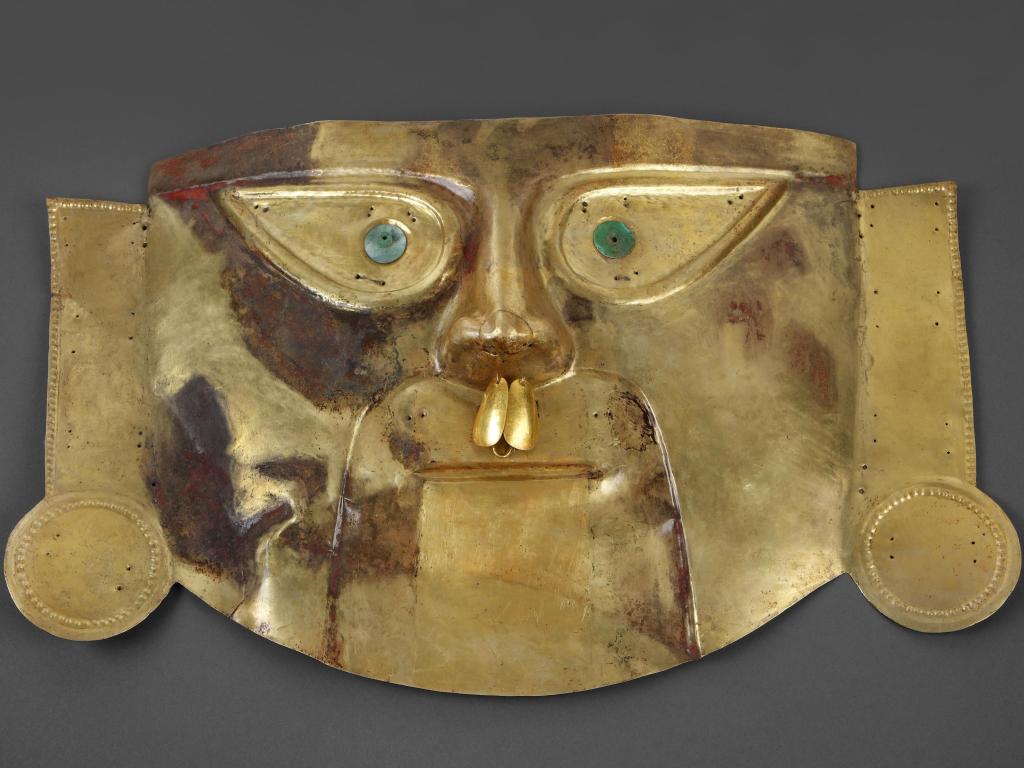SICÁN-LAMBAYEQUE culture, North coast 750–1375 AD. Mask, gold, chrysocolla, cinnabar; 30.6 x 49.7 cm; Museo Oro del Perú, Lima. Photograph: Daniel Giannoni
Though somewhat ill-named – perhaps because the title Gold and the Nazca, Moche, Huaru, Sicán-Lambayeque, Chimú, Chancay, Chiribaya and Incas was considered too unwieldy – this fascinating exhibition at the National Gallery of Australia provides striking insights into the many Indigenous cultures of Peru, whose flowering was cut brutally short by the Spanish invasion of 1532-33.
For more than 3000 years before the Spanish arrived in South America, great cultures rose and fell, were conquered by others or absorbed into them. Almost every artefact that survives was buried with their owners, to be re-discovered in modern times. In the last 100 years there have been extraordinary archaeological finds, and much scientific research is occurring today.
Cleanly curated and arranged chronologically, the exhibition explores the many cultures who predated the Incas, and the Incas themselves, detailing their common beliefs in a three tiered world: the sky realm, populated by the gods (represented by birds), the earth, the realm of humanity (represented by felines) and the underworld, the realm of the dead (represented by serpents). These shared motifs appear frequently throughout the exhibition, meticulously carved in stone, woven in fabrics whose colours are still vivid and striking, and beaten and embossed in silver and gold.
Some of the exhibits are strikingly simple, but speak clearly of the humble toil of daily life, such as a granite mortar from the early Pacopampa culture, circa 1200 BC. Other works are more ornate, yet still deeply personal, such as a series of vessels from the Moche culture of northern Peru, whose carefully sculptured ceramic vessels clearly represent faces from the past, complete with individual details such as a scarred lip and puffy eyelids. Other works are more playful, such as a collection of sexually explicit vases and vessels depicting copulating couples which some visitors may find a little risque.
Though many mummified bodies have been discovered in Peru in the last century, no such mummies are included in the exhibition. Instead, the grave goods which were carefully interred alongside their owners make up the bulk of the exhibition – including the golden artefacts on display, which thankfully escaped the fate of so much Peruvian gold, which was melted down by the Spanish and shipped back to Europe.
Though some of the golden objects on display are truly spectacular – such as pectoral and nasal adornments, earrings and crowns, detailed human figures, and a set of tiny but beautiful gold llamas – the most striking works to this reviewer’s mind are the colourful textiles, such as a wool and cotton bag created circa 100 – 700 AD, woven of bright geometric shapes and adorned with tassles, which would not be out of place in Fitzroy, Newtown or Northbridge even today; and the fragile but beautiful open-weave garments of the Chancay.
Visitors expecting to see mostly works from the short-lived Inca Empire may be surprised to find only a single room devoted to their culture – though such a surprise is lessened once one learns of the destruction wreaked by the Spanish (more than 10 million people – perhaps 90% of Inca society – were killed by the Spanish or died of disease and famine following the conquistador invasion). Nonetheless, some quibbles remain – it was, for instance, slightly frustrating to see examples of quipu (knotted threads and cords used by the Incas to communicate and record numerical information) without any suggestions as to what each quipu might have been tallying or accounting for.
Such minor distractions aside, Gold and the Incas is a fascinating exhibition, and definitely worth including on your next visit to the NGA.
Rating: 4 stars out of 5
Gold and the Incas: Lost worlds of PeruNational Gallery of Australia, Canberra
6 December 2013 – 21 April 2014





